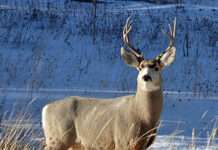Well it’s time again for both the largest and the smallest birds in Kansas to make their spring appearances. Turkey Vultures, being of course the largest are here already. There are probably more yet to come as they make their way back from their winter digs in South America. Ruby Throated Hummingbirds, being the smallest, also winter in South America and are due back in KS around the middle of April; the earliest sighting last spring was on April 14 in Wichita.
Some years back Joyce and I had the opportunity to keep tabs on a pair of Turkey Vultures nesting in an old ramshackle building near Inman that had been a vulture nursery for years. We got within a couple feet of the female as she guarded her nest, and checked on her weekly as she hatched 2 little white balls of fluff that quickly grew into immense specimens like their parents. Despite having faces only a mother could love, vultures are an important part of our ecosystem. Often known as nature’s clean-up crew, they clean up dead wildlife and animals of all descriptions and the juices in their digestive systems are so potent they can eat diseased flesh with no repercussions. Our last visit to the old building that year found both youngsters perched on an old windmill tower near the building, curiously watching us below as mom and dad both circled above. As majestic and awesome as Turkey Vultures are as they soar effortlessly above us on the Kansas winds, there are few if any opportunities for us to interact with them, and perhaps rightly so.
But we often design our entire back yards foliage to attract hummingbirds and hang nectar feeders to cater to their “sweet tooth,” and are sometimes rewarded with “close encounters” as the little blighters become comfortable with our presence. Hummingbirds were much more prevalent in Ohio where I grew up, and we often saw 3 or 4 at once at our feeders. One feeder hung in front of a back porch near our kitchen, and the little hummers’ learned to hover outside a nearby window to get our attention when the feeder was empty. Once after filling the feeder, I slipped quietly out onto the porch and one hungry little hummer actually drank from it as I stood there motionless, holding the feeder at arm’s length.
At last week’s McPherson Spring Garden Show, Mike Daniels, owner of Brook’s Landscape LLC spoke about “Gardening for Friends,” and his main topic was hummingbirds and gardening to attract them. With wings that beat over 50 times per second, hummingbirds can make the trip across the Gulf of Mexico back to the US in 18 – 22 hours, resting on boats and oil derricks if necessary. It’s always been said that hummingbirds are attracted to the color red, but Daniels said that because of the way they see colors, any color using red in its spectrum will attract them, so orange, yellow and purple should all work as well.
Hummers’ also have a voracious appetite for insects and have actually been observed robbing trapped bugs from spider webs. They make nests from thistle down and dandelion leaves and weave it all together with spider silk from spider webs. The female usually sits on 2 jelly bean sized eggs and they can have 2 broods a year.
Daniels suggests trying to attract them with plants and using feeders as a backup. He says to keep the feeders clean and free from mold and dirt, and when mixing the nectar, boil the water and add sugar at the rate of 1 part sugar to 4 parts water to make a syrup that does not sour as quickly as plain sugar water. Hang feeders in partial shade several feet apart to help keep the males from fighting and hang them where cats can’t get to them. We’ve all heard it said that keeping feeders out too late in the fall might encourage hummingbirds to stay later than they should and miss their fall migration. Daniels told us that is not a problem, as the little guys’ God given instinct and the absence of insects will send them on their way south right on time. Hummingbirds love petunias and trumpet vine, and salvia, angelonia, morning glory, beard tongue, coral bells and bee balm are also very attractive to them; these plants will all attract butterflies as well. Stay away from insecticides and pesticides if possible and use herbicides sparingly.
Yes it’s time for the greatest and the smallest in the Kansas skies to appear once again from their winter homes far to the south. Look to the sky as the air warms on spring mornings and you’re bound to spot vultures effortlessly soaring above as they ride the rising columns of warm air known as thermals. Get you hummingbird feeders cleaned and ready and spruce up your lawn with a few new plants, and prepare to be entertained by the buzzing sound of little wings and the chattering of jousting hummingbirds as they chases each other across your back yard. What a great time to Explore Kansas Outdoors!
Steve can be contacted by email at [email protected].




